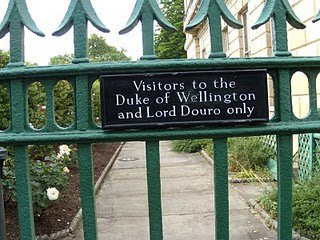Recently, Victoria and I embarked on another of those musing, rambling, disjointed conversations we often have about London.
“We’d better figure out exactly what we want to do in London on the Tour so Patty will be able to start blocking out all the travel details,” I said to Victoria.
“What travel details?” she asked.
“Hotel rooms, motor coach and driver, meals, admissions. Like that.”
“Thank God we have Patty and Novel Explorations for all that. We can concentrate on all the fun stuff instead.”
“We should stay in either Victoria or Mayfair. That way, we’ll be in walking distance to everything.”
“Yeah,” Victoria agreed before staring off into the distance, no doubt dreaming of walking the streets of London again. I began thinking of London myself. In my mind’s eye, I walked down Buckingham Palace Road – the Royal Mews, the giftshop next door, down the sidewalk and round to the left in order to stare through the gates at Buckingham Palace. Sigh.
We sat in silence for a time until I finally said, “We have to take the Tour to see the Palace at night.”
“Definitely,” Victoria agreed. “But what happens if some of the people on our Tour have already seen the Palace?”
“How many times have you seen it?”
“Jeez, I don’t know. Lots.”
“And we still go back and gawk at it every time we’re there, right? Believe me, no one will complain about seeing the Palace at night.”
“Then we can toddle our way up to Apsley House and see that at night,” Victoria sighed.
“Then we can walk down Piccadilly to St. James’s Street and do all the Lions.”
Victoria gave me an odd look. “The lions are in Trafalgar Square.”
“Not those lions. The pubs. The Red Lion, the Golden Lion . . . . . “
“Oh, we’ve got to take them to the Golden Lion, it’s like stepping back in time. And if we do that, then we’ve got to walk down the street to Almack’s.”
“Definitely. We can tell the group about Wellington’s being refused admission because he was wearing boots.”
“I thought it was because he arrived after eleven o’clock.”
“Depends which version of the story you want to believe,” I said. “I can just see Wellington strolling through the Park to Almack’s. Can you picture it?”
“Walk? Wouldn’t he have ridden there?”
“Nah. Then he’d have to put his horse somewhere. Much faster and easier to walk. Think about it. He’d only have had to cross the road in front of Apsley House and then cut through Green Park diagonally and he’d have been in King Street.”
“He’d have had to cut through somewhere to get to St. James’s Street,” Victoria mused.
“He could easily have cut through the back of Spencer House.”
“Spencer House? Cut through Spencer House?”
“We’re talking about the Duke of Wellington here. Do you really think Earl Spencer was going to tell him that he couldn’t cut through his yard?”
In response to this, Victoria said, “If we’re going to go to King Street, then we might as well just walk down another block to St. James’s Palace.”
“I love seeing London by night,” I sighed.
“Yeah. The streets are empty, it’s quiet and you can actually imagine that it’s 1805 again.”
“Cobblestones.”
“Hmmm. Damp cobblestones,” Victoria said.
“Damp cobblestones shining in the lamplight. And it’s got to be the tiniest bit chilly.”
“Definitely. Not actually cold, though.”
“No,” I agreed, “not cold. Just nippy.”
“Just nippy enough for us to be able to drop into the Golden Lion and casually order a glass of port.”
“Ooooh, port.”
“So Wellington, no?” Victoria asked.
“Oporto,” I said, prompting both of us to stare off into the middle distance for the next few minutes.
“Have you ever been to Duke’s Hotel?” I finally asked.
“No. Why?”
“They’re supposed to have a fabulous bar. I’ve always meant to go, but time just gets away from me when I’m in London. We should stop in there for a drink.”
“What’s the Wellington connection to Duke’s?” Victoria asked.
“Er, it’s called Duke’s?”
“Yes, but not that Duke, is it?”
“I don’t think so, but it’s definitely a part of Wellington’s London. Not to mention that it’s in the same street as Spencer House, so Artie would definitely have known it. I think it was lodgings for wealthy bachelors back then. And Mrs. Delaney lived in the street, too.”
“Isn’t that where Domenico Angelo had his school?” Vicky asked.
“Who?”
“Angelo. The fencing master.”
“Ah. Could be. Google it,” I suggested.
Victoria Googled, using her tablet. “St. James’s Place. Let’s see . . . . Spencer House . . . . Duke’s Hotel . . . . Oh, God, listen to this, there’s a Blue Plaque in St. James’s Place for William Huskisson!”
“Our William Huskisson?”
“Yes, our William Huskisson, the one who was run over by the train right in front of Wellington. England’s first railroad fatality.”
“Well that seals the deal then. We’re going. And we’ll drink a toast to him in the bar of Duke’s Hotel.”
“Oooh, this is such fun!”
“It is. And we’ve got the whole rest of the tour to flesh out. This is just about three hours of it, so far.”
“I can’t wait to go,” Victoria said wistfully.
“Don’t get too excited. We have almost an entire year to wait. Why did we plan it so far in the future? What were we thinking?”
“I guess we’re just gluttons for punishment.”
You are cordially invited to join us September 4-14, 2014!

































